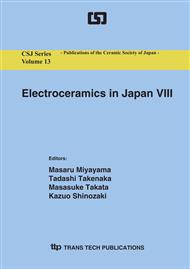p.143
p.147
p.151
p.155
p.159
p.163
p.167
p.171
p.177
High-Rate Charge/Discharge Properties of Li Ion Secondary Battery Using V2O5/Carbon Composite Electrodes with Carbon Fiber
Abstract:
The charge/discharge properties of V2O5/carbon composites with controlled microstructures were investigated to achieve a high-rate lithium electrode performance. Composite electrodes were synthesized by mixing a V2O5 sol, carbon and a surfactant, followed by drying. V2O5/AB (acetylene black) and V2O5/VGCF (vapor-grown carbon fiber) composite electrodes showed high-rate charge/discharge properties only when they had very high carbon contents. V2O5/ (AB and VGCF) composite electrodes with controlled microstructures exhibited a discharge capacity of 245 mA·h·g-1 at a high current density of 40 A·g-1, which was approximately 70% of that at a low current density of 100 mA·g-1. The improvement in the high-rate charge/discharge properties was attributed to the short lithium ion diffusion distance, large reaction area and high electronic conductivity of those composite electrodes.
Info:
Periodical:
Pages:
159-162
Citation:
Online since:
January 2006
Authors:
Price:
Сopyright:
© 2006 Trans Tech Publications Ltd. All Rights Reserved
Share:
Citation:


